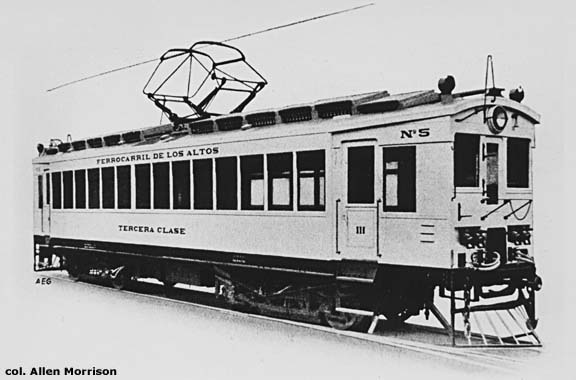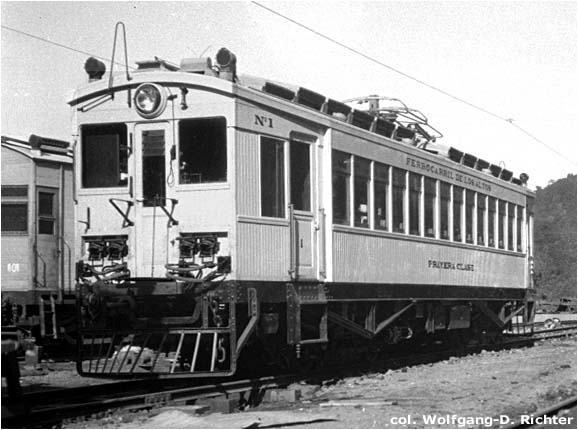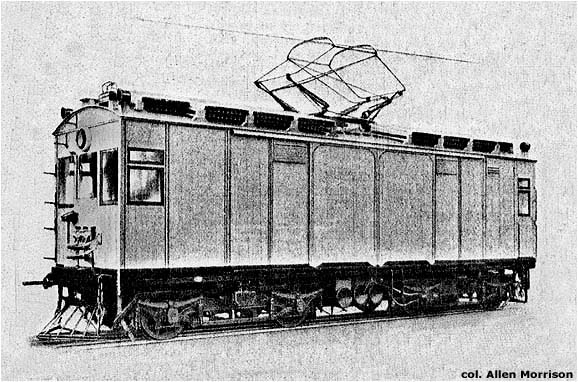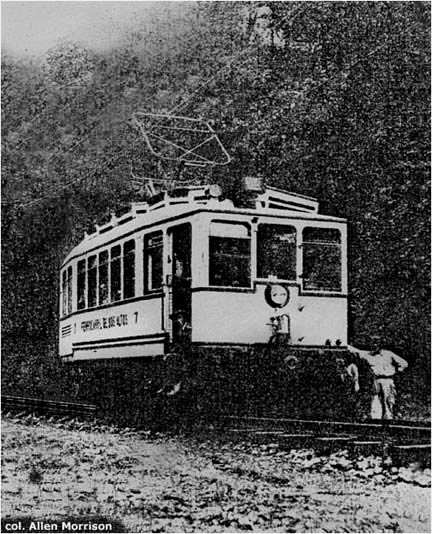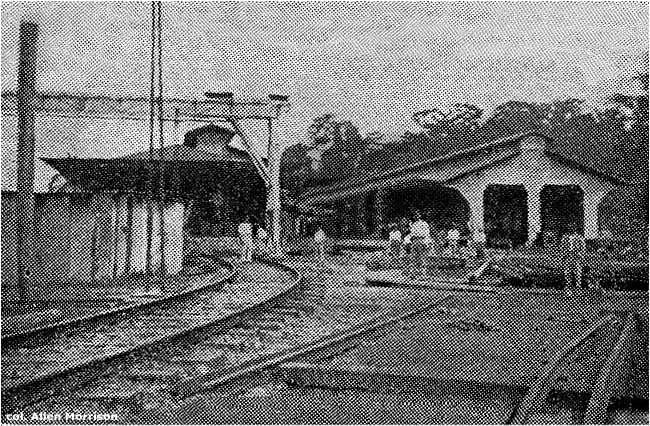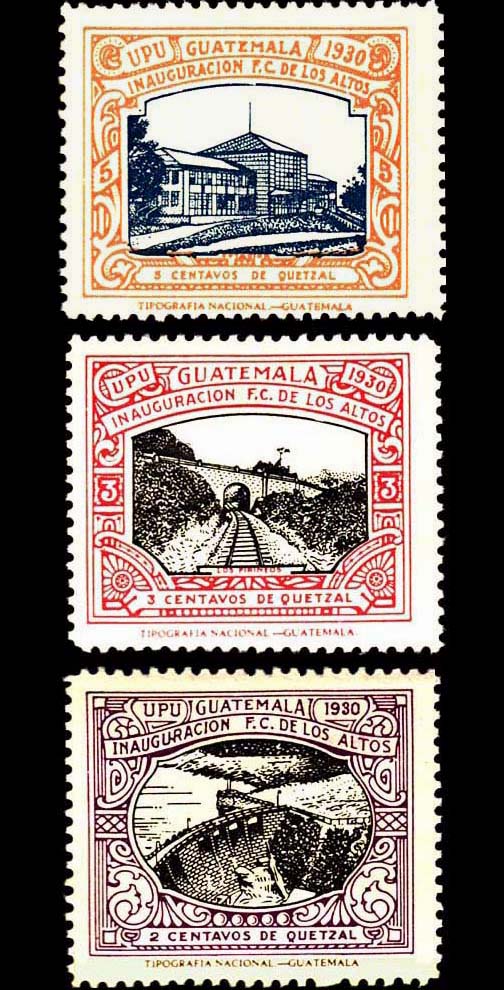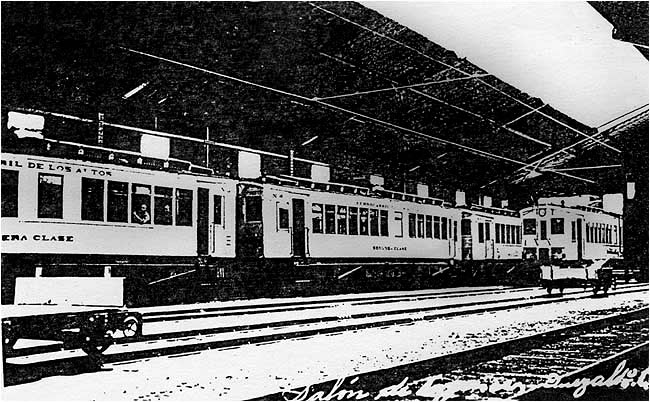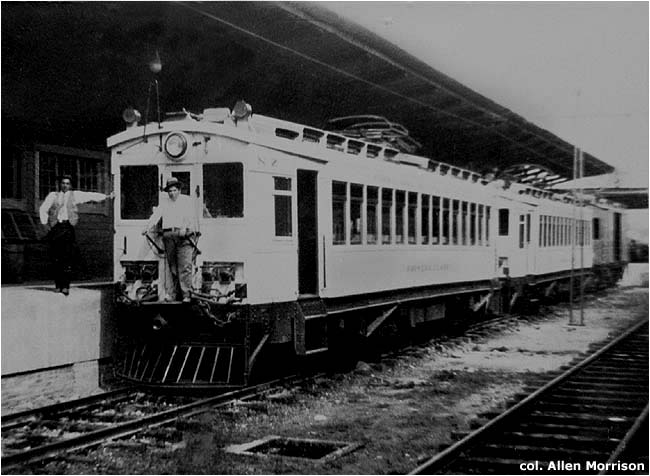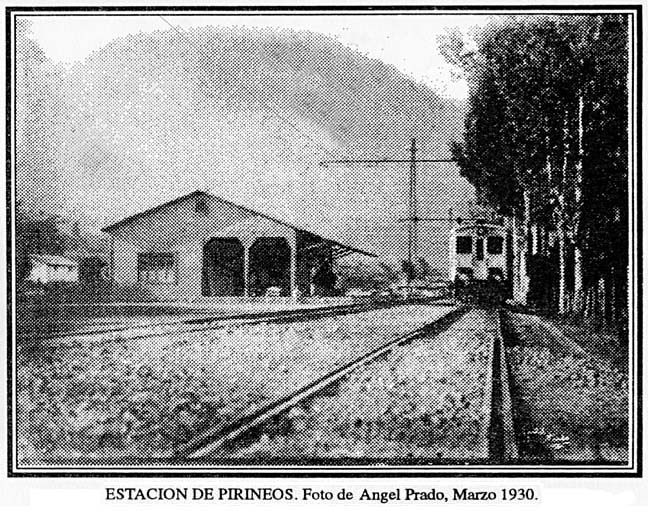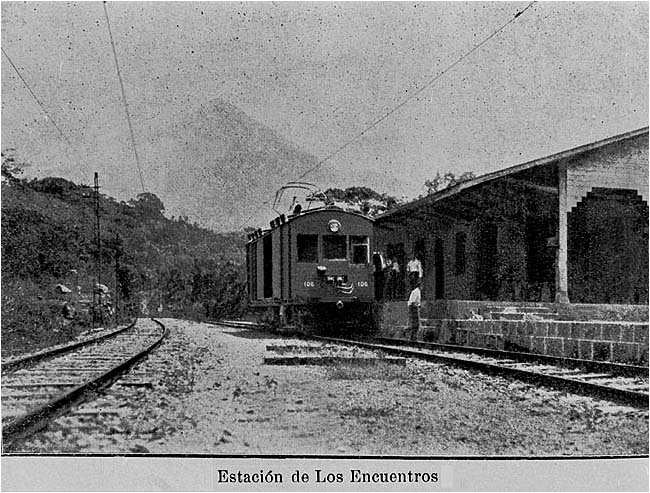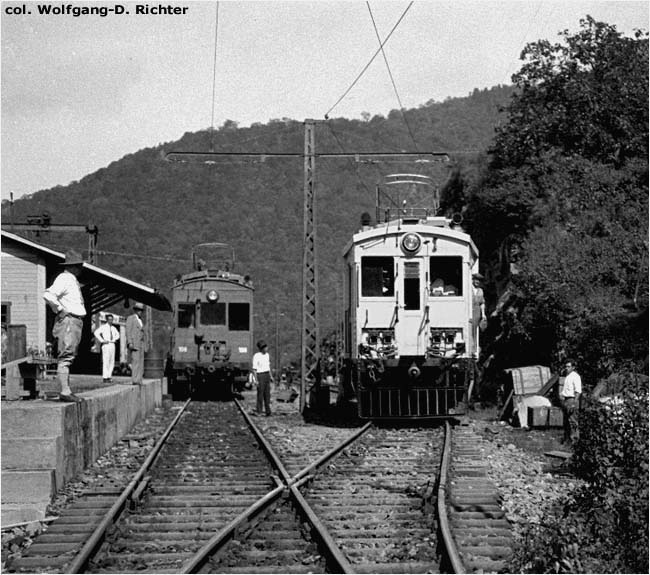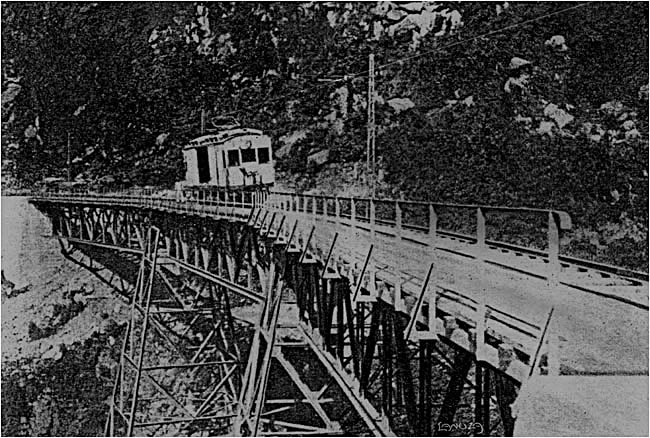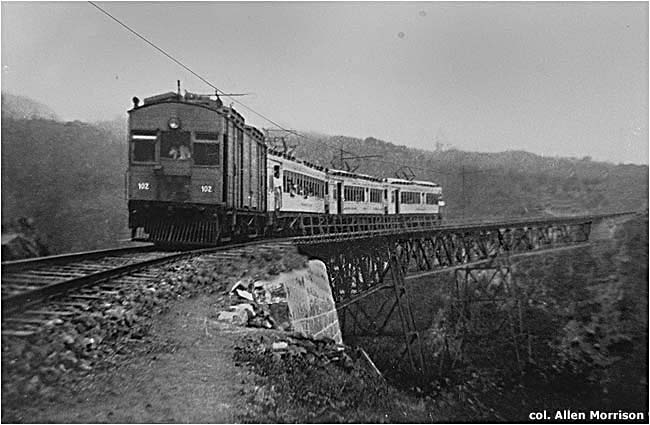Ferrocarril de Los Altos
Quezaltenango Electric Railway
GUATEMALA
by
Allen Morrison
Guatemala is the westernmost of the seven countries that comprise Central America, and one of five that has ports on both the Atlantic (Caribbean Sea) and Pacific oceans. It is about the size (and shape) of Louisiana in the United States. Quezaltenango, its second-largest city and the capital of Quezaltenango department, sprawls high in the mountains at 2360 m (7743 ft), 206 km west of Guatemala City [see area map]. Its population was about 50,000 in 1930, is about 300,000 today. The name is sometimes spelled Quetzaltenango. Residents call the place Xela ("shay-la"). With construction in the 19th century of the Ferrocarril Central de Guatemala across the central plain, plans began for a rail line up to Quezaltenango in the highlands. Engineers surveyed the area in 1891 and proposed a rack railway, like those that had been built recently in Venezuela and Brazil. Construction began in 1899 and continued on and off for years, finally ending with a government change in the 1910s. A new committee proposed an electrically powered adhesion line in 1920, the new Guatemalan administration approved the project and, to finance it, levied a 3 peso tax on alcoholic beverages. The new railway would be called Ferrocarril de Los Altos [hereafter "FLA"]. On 25 September 1924 FLA signed a contract with Allgemeine Elektricitäts Gesellschaft of Berlin to build a 28-mile electric railway between Quezaltenango and San Felipe, the terminus of a branch of International Railways of Central America, which had absorbed the Guatemalan railroads in 1912 [see map]. The contract also specified six 4-axle passenger cars, nine 4-axle freight cars and one 2-axle inspection car. The following drawing appeared in an article about the project that was published in a German transport magazine in 1931 ["Die Gebirgsbahn", p. 298: see BIBLIOGRAPHY]:
AEG provided the electrical equipment but subcontracted the construction of the rolling stock to Familleureux in La Louvière, Belgium. The photograph below of Third Class passenger car Nº 5, rather different from the model in the drawing, appeared in a Familleureux brochure:
It is not known if a car was built like the model in the drawing. FLA passenger cars 1 and 2 were Primera Clase, 3 and 4 were Segunda Clase and 5 and 6 were Tercera Clase. Here is another view of Nº 5, published in another German magazine in 1932 ["Betrieb", p. 87: see BIBLIOGRAPHY]. It shows the other side of the car, which had a simpler window arrangement:
Primera Clase car Nº 1 seems to have been identical, at least on the outside, to Nº 5 above [col. Wolfgang-D. Richter]:
Here is one of the nine 15-ton freight motors, which were numbered 101-109 ["Betrieb", p. 86: see BIBLIOGRAPHY]:
And here is the only known photograph of the 2-axle inspection car, numbered 7 [col. AM]:
AEG built a dam on the Samalá River and a 12,000 HP electric plant near Santa María (altitude 1559 m), about halfway up the mountain [see map]. Construction of the railway began at San Felipe (altitude 629 m), terminus of the IRCA branch from Muluá. This enlargement of a small picture found in a 1933 guidebook shows San Felipe station under construction [Guía manual, p. 122: see BIBLIOGRAPHY]:
The first 16 km of the line, between San Felipe and Santa María, were completed in 1928 [see map]. The rolling stock arrived from Europe and FLA began carrying passengers informally on that section – until the derailment of freight motor 103 in December 1928 which killed three electricians. No passengers were carried for the next 15 months. Finally, on Sunday 30 March 1930 Ferrocarril de Los Altos formally inaugurated its entire 44-km electric railway from San Felipe to Quezaltenango. A song was composed for the occasion and Correos de Guatemala issued the following three stamps. The first shows the Quezaltenango passenger terminal – which still stands today:
AEG constructed the FLA with standard 1435 mm gauge track, even though all other railways in Guatemala, including the branch line that it adjoined at San Felipe, used 914 mm gauge [see map]. AEG claimed that narrow-gauge trucks would not allow space for the powerful motors and electromagnetic brakes that were needed for the line's 9.25% grade [see Betrieb in BIBLIOGRAPHY]. The FLA climbed 1731 m in 44 km, had a 300 m tunnel and seven bridges, some of them quite high. The project cost the Guatemalan government USD $8.5 million. The postcard view below shows the train sheds in Quezaltenango. The car in the middle is Segunda Clase Nº 4 [col. AM]:
Here is Primera Clase car Nº 2 in Quezaltenango station [col. AM]:
Segunda Clase Nº 4 and another car in the yard outside Quezaltenango station [Arriola: see BIBLIOGRAPHY]:
A 3-car train in the Quezaltenango yard. The view is south, toward the passenger terminal on 4ª Calle (4th Street). The train will travel north on 20ª Avenida for several blocks, then veer east on 11ª Calle across the north side of the city. Near Cantel the line turned south toward San Felipe. FLA built its terminal on the north side of Quezaltenango because it planned other lines to San Marcos and Totonicapán [see map] [Arriola: see BIBLIOGRAPHY]:
In 1931 the railway inserted the word "Nacional" into its name. The timetable below, dated 7 May 1932 and published in a 1933 guidebook, shows two daily round trips between Quezaltenango and San Felipe [see map]. Trains 3 and 2 met at Zunil. The numerals after the clock times indicate layover minutes at the station and travel time to the next station [Rubio: see BIBLIOGRAPHY]:
This undated chart of First and Second Class fares was published in 1933 in another guidebook. Prices are in quetzals, the Guatemalan currency. Unlike the timetable above, this list notes distances from Quezaltenango [Guía manual: see BIBLIOGRAPHY]:
Pictures of FLA cars in operation on the line are very rare. Here are four of the best that could be found. The first shows a passenger car at Pirineos station, not far from Santa María [see map] [Angel Prado in Reseña Histórica by Cajas Ovando: see BIBLIOGRAPHY]:
Freight motor 106 at Los Encuentros station, near San Felipe [see map]. Note that the building has the same architecture as Pirineos station above [Arriola: see BIBLIOGRAPHY]:
Freight motor 108 and an unidentified passenger car at an unidentified station [col. Wolfgang-D. Richter]:
A freight motor on one of the high bridges [Arriola: see BIBLIOGRAPHY]:
Freight motor 102 connected to three crowded passenger cars, all with pantographs raised. Some passengers liked to ride outdoors. Date of this picture is unknown [col. AM]:
The Ferrocarril (Nacional) de Los Altos was a magnificent railroad, one of the most spectacular in the Americas. It was the only electric railroad of any kind in Guatemala (its capital, Guatemala City, never had electric trams) and was one of the few genuine interurban electric lines in Latin America. But it was a financial disaster. The wagon trails that inspired its construction in the 19th century were paved highways by 1930 and buses and automobiles ran everywhere. FLA trains averaged only 200 passengers a day and freight was far below estimates. Revenue did not even cover operating costs. A storm on 19 September 1933 flooded the lower section, caused mudslides on the mountainside and damaged two bridges. The government refused to rebuild. Residents offered to repair the line at their expense, but were rebuffed. Guatemalan president Jorge Ubico prosecuted volunteers, dismissed all FLA employees, ordered that the railway be dismantled, the rails used as lamp posts, the ties and buildings used for fuel, and the rolling stock sold for scrap. Because of their electric motors and standard gauge trucks they had no other use in Guatemala. Quezaltenango's legendary electric railway was declared permanently closed on 10 November 1933. It had run only 3 1/2 years. Most traces of the FLA have disappeared today. But the railway tunnel near Zunil is used by automobiles and the passenger terminal on 4ª Calle in Quezaltenango is intact and has become the city's Centro Intercultural. It includes a small Museo del Ferrocarril de Los Altos.
BIBLIOGRAPHY "Guatemala Builds Electric Railroad" in Electric Railway Journal (New York), 8/1928, p. 182. Nice half-page description of the project. "Guatemala Railway Suspends" in Electric Railway Journal (New York), 8/12/1928. Brief news item about the 1928 accident. Arriola, Osmundo. Quezaltenango: álbum conmemorativo de la inauguración del Ferrocarril Nacional de los Altos. Quetzaltenango, 1930. A 48-page booklet about the inauguration. Numerous illustrations of the cars and line, poorly printed. "Los Altos Railway, Guatemala" in U.S. Bureau of Foreign & Domestic Commerce's Commerce Reports: Transportation: Railways (Washington), 11/5/1931, pp. 360-361. Full-page description of the railway. One picture. "Die Gebirgsbahn San Felipe - Quezaltenango (Guatemala)" in Waggon- und Lokomotivbau (Leipzig), 24/9/1931, pp. 295-298. Good 4-page article with map (!), two drawings and four photographs of the line (no views of the cars). "Betrieb einer steilen Reibungsbahn in Guatemala" in Elektrische Bahnen, Zentralblatt für den Elektrischen Zugbetrieb (Charlottenburg), 4/1932, pp. 85-87. Extraordinary, very detailed technical article with two superb photographs (reproduced herein) and three charts. Emphasis on the electro-magnetic brakes and the choice of standard gauge: "Die Spurweite der neuen Bahn wurde zu 1435 mm festgesetzt, weil wegen des reinen Triebwagenbetriebes, der sich bei der großen Steigung ergab, ein Übergang der Fahrzeuge von einer zur anderen Bahn ohnedies nicht möglich war und die schmale Spur die Leistungsfähigkeit der elektrischen Triebwagen zu sehr beschränkt hätte" (p. 85). Rubio, Julio Alberto. Guía ilustrada de turismo en Guatemala / Illustrated Tourist Guide to Guatemala [both Spanish and English editions] Guatemala City, 1933. Nice guidebook. FLA timetable, p. 18, reproduced above. Large map of Guatemala in pocket shows railway network in 1933, including FLA. Guía manual de turismo, 1933-34. Guatemala City, 1933. Another guidebook. Picture of San Felipe station, p. 122, and a fare chart, p. 224, reproduced above. Jones, Chester Lloyd. Guatemala, Past and Present. New York, 1966. Guatemala's disastrous railway adventure, pp. 37-38. Benjamin, C. E. "A Guat-A-Molly Trolley" in Traction & Models (Indianapolis), 9/1980, pp. 11-12. Wonderful, concise description of the railway project and operation. Map, two pictures and timetable (from Rubio's Guía, above). Cajas Ovando, Francisco José. Reseña Histórica del Ferrocarril de Los Altos. Quetzaltenango, 1995. The definitive text in Spanish, 16 pages. Five photographs, unfortunately not well reproduced. XELA FERROCARRIL DE LOS ALTOS. Extraordinary motion picture footage of the railway taken in the 1920s and 30s: scenes of the Santa María dam, the passenger cars and the right-of-way. Part 1 (9:53). Part 2 (8:11). El Ferrocarril de los Altos. A 67-second YouTube presentation shows the inauguration of the line in 1930. Lots of people. Only brief glimpses of the FLA cars in the background. Photograph of the north portal of the Zunil tunnel by E. Aldana. Historia de Guatemala 04 - Ferrocarril de los Altos. One of several YouTube presentations of Quezaltenango's best known melody. Luis Escobar. Ferrocarril (Nacional) De Los Altos. 3/2012. Nicely assembled 9-minute pastiche of old photographs, including (without credit) several copied from this page.
The author is indebted to Lars Richter of Hamburg, Germany,
For information about other electric railways see If you have comments, criticism or suggestions, This page was placed online on Copyright © 2008-2108 Allen Morrison |


